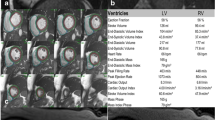Abstract
Evaluating valvular heart disease requires a multi-parametric analysis of valvular pathology, hemodynamic derangements, and impact on ventricular size and function. The capability to perform real-time three-dimensional (3-D) imaging has vastly strengthened the already established role of echocardiography. CT and MRI advances have led to their use as daily clinical tools. Two-dimensional and 3-D echocardiography and Doppler modalities allow for accurate assessment of valvular lesions, pressure gradients, stenotic valve orifice areas, pulmonary artery pressures, intracardiac pressures, and regurgitant volumes. Quantitation of chamber volumes has become more accurate and reproducible with 3-D echocardiography, CT, and cardiac MRI. Although ultrasound imaging is the primary tool, the other techniques provide adjuvant or alternate options to examine valvular heart disease. This array of imaging modalities is likely to provide greater insights into the pathophysiology of valvular heart disease, new pointers to prognosis, and also guide innovative treatment strategies.
Similar content being viewed by others
References and Recommended Reading
Carbello BA, Crawford FA: Valvular heart disease. N Engl J Med 1997, 337:32–41.
American College of Cardiology/American Heart Association Task Force on Practice Guidelines; Society of Cardiovascular Anesthesiologists; Society for Cardiovascular Angiography and Interventions; Society of Thoracic Surgeons, Bonow RO, et al.: ACC/AHA 2006 guidelines for the management of patients with valvular heart disease: a report of the American College of Cardiology/American Heart Association Task Force on Practice Guidelines. Circulation 2006, 114:e84–e231.
DeCastro S, Salandin V, Cartoni D, et al.: Qualitative and quantitative evaluation of mitral valve morphology by intraoperative volume-rendered three-dimensional echocardiography. J Heart Valve Dis 2002, 11:173–180.
Sugeng L, Coon P, Weiner L, et al.: Use of real-time 3-dimensional transthoracic echocardiography in the evaluation of mitral valve disease. J Am Soc Echocardiogr 2006, 19:413–421.
Zamerano J, Cordeiro P, Sugeng L, et al.: Real-time threedimensional echocardiography for rheumatic mitral valve stenosis evaluation: an accurate and novel approach. J Am Coll Cardiol 2004, 43:2091–2096.
Vogel-Claussen J, Pannu H, Spevak PF, et al.: Cardiac valve assessment with MR imaging and 64-section multi-detector row CT. Radiographics 2006, 26:1769–1784.
Pennell DJ, Sechtem UP, Higgins CB, et al.: Clinical indications for cardiovascular magnetic resonance (CMR): consensus panel report. Eur Heart J 2004, 25:1940–1965.
Schwitter J: Valvular heart disease: assessment of valve morphology and quantification using MR. Herz 2000, 25:342–355.
Willmann JK, Weishaupt D, Lachat M, et al.: Electrocardiographically gated multi-detector row CT for assessment of valvular morphology and calcification in aortic stenosis. Radiology 2002, 225:120–128.
Boxt LM, Lipton MJ, Kwong RY, et al.: Computed tomography for assessment of cardiac chambers, valves, myocardium and pericardium. Cardiol Clin 2003, 21:561–585.
Faletra F, Pezzano A, Jr, Fusco R, et al.: Measurement of mitral valve area in mitral stenosis: four echocardiographic methods compared with direct measurement of anatomic orifices. J Am Coll Cardiol 1996, 28:1190–1197.
Zamorano J, Perez de Isla L, Sugeng L, et al.: Non-invasive assessment of mitral valve area during percutaneous balloon mitral valvuloplasty: role of real-time 3D echocardiography. Eur Heart J 2004, 25:2086–2091.
De Castro S, Salandin V, Cavarretta E, et al.: Epicardial real-time three-dimensional echocardiography in cardiac surgery: a preliminary experience. Ann Thorac Surg 2006, 82:2254–2259.
Agricola E, Oppizzi M, Pisani M, et al.: Accuracy of realtime 3D echocardiography in the evaluation of functional anatomy of mitral regurgitation. Int J Cardiol 2007, [Epub ahead of print.]
Patel A, Mochizuki Y, Yao J, Pandian NG: Mitral regurgitation: comprehensive assessment by echocardiogram. Echocardiography 2000, 17:275–283.
Alkadhi H, Wildermuth S, Bettex D, et al.: Mitral regurgitation: quantification with 16-detctor row CT-initial experience. Radiology 2006, 238:454–463.
Hatle L, Angelsen BA, Tromsdal A: Non-invasive assessment of aortic stenosis by Doppler ultrasound. Br Heart J 1980, 43:284–292.
Malyar NM, Schlosser T, Buck T, et al.: Using cardiac magnetic resonance tomography for assessment of aortic valve area in aortic valve stenosis. Herz 2006, 31:650–657.
Pouleur AC, le Polain de Waroux JB, Pasquet A: Aortic valve area assessment: mMultidetector CT compared with cine MRI imaging and transthoracic and transesophageal echocardiography. Radiology 2007, 244:745–754.
Mesisika-Zeitoun D, Aubrey MC, Detaint D, et al.: Evaluation and clinical implications of aortic valve calcification measured by electron-beam computed tomography. Circulation 2004, 110:356–362.
Rosenhek R, Binder T, Porenta G, et al.: Predictors of outcome in severe, asymptomatic aortic stenosis. N Engl J Med 2000, 343:611–617.
Anwar AM, Soliman O, van den Bosche AE, et al.: Assessment of pulmonary valve and right ventricular outflow tract with real-time three-dimensional echocardiography. Int J Cardiovasc Imaging 2007, 23:167–175.
Maslow AD, Schwartz C, Singh AK: Assessment of the tricuspid valve: a comparison of four transesophageal echocardiographic windows. J Cardiothorac Anesth 2004, 18:719–724.
deFilippi C, Willett D, Brickner E, et al.: Usefulness of dobutamine echocardiography in distinguishing severe from non-severe valvular aortic stenosis in patients with depressed LV function and low transvalvular gradients. Am J Cardiol 1995, 75:191–194.
Mohan JC, Patel AR, Passey R, et al.: Is the mitral valve area flow-dependent in mitral stenosis? A dobutamine stress echocardiographic study. J Am Coll Cardiol 2002, 40:1809–1815.
Otto C, Burwash I, Legget M, et al.: Prospective study of asymptomatic valvular aortic stenosis. Circulation 1997, 95:2262–2270.
Author information
Authors and Affiliations
Corresponding author
Rights and permissions
About this article
Cite this article
Aguilar, F., Joachim Nesser, H., Faletra, F. et al. Imaging modalities in valvular heart disease. Curr Cardiol Rep 10, 98–103 (2008). https://doi.org/10.1007/s11886-008-0018-0
Published:
Issue Date:
DOI: https://doi.org/10.1007/s11886-008-0018-0




